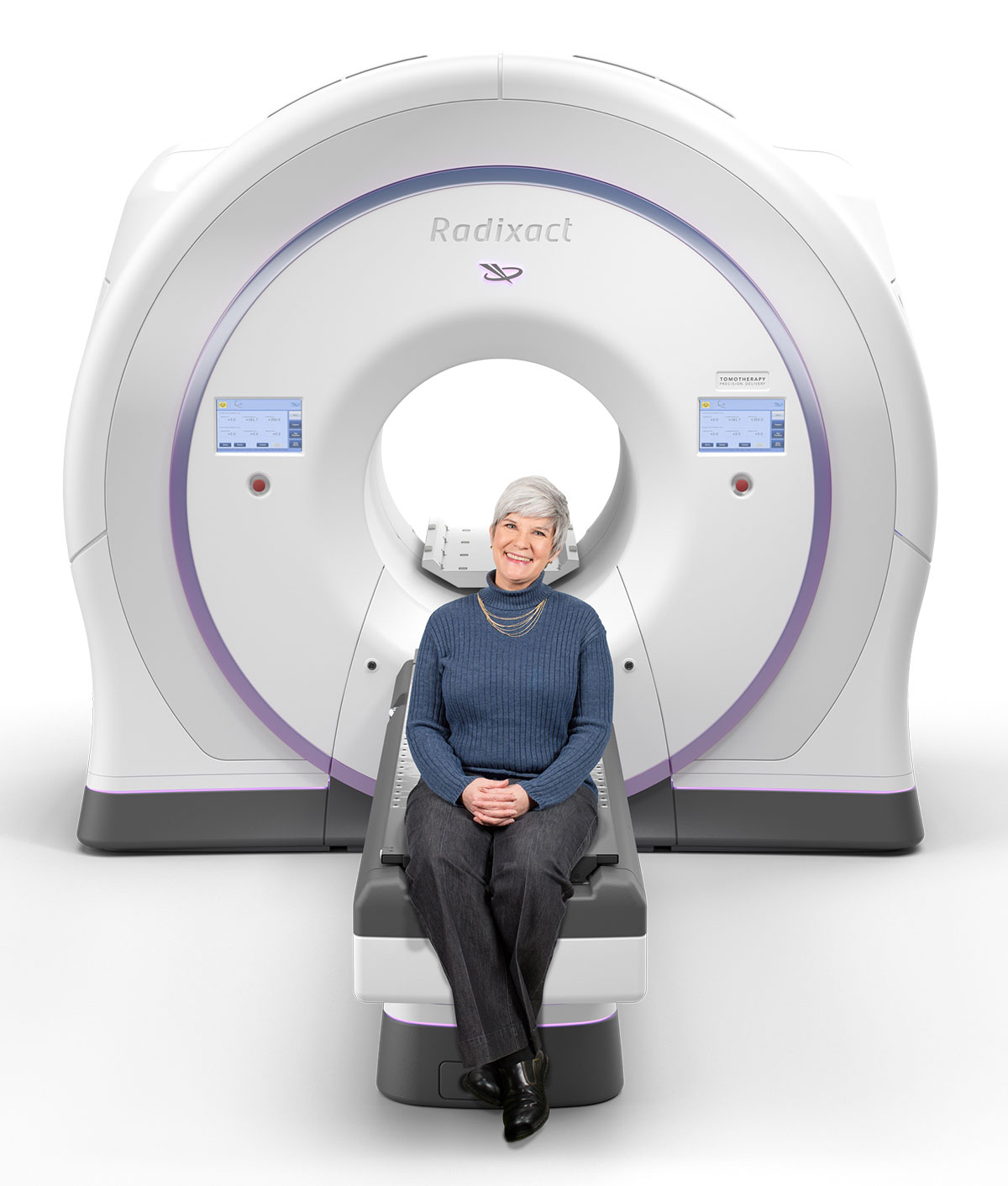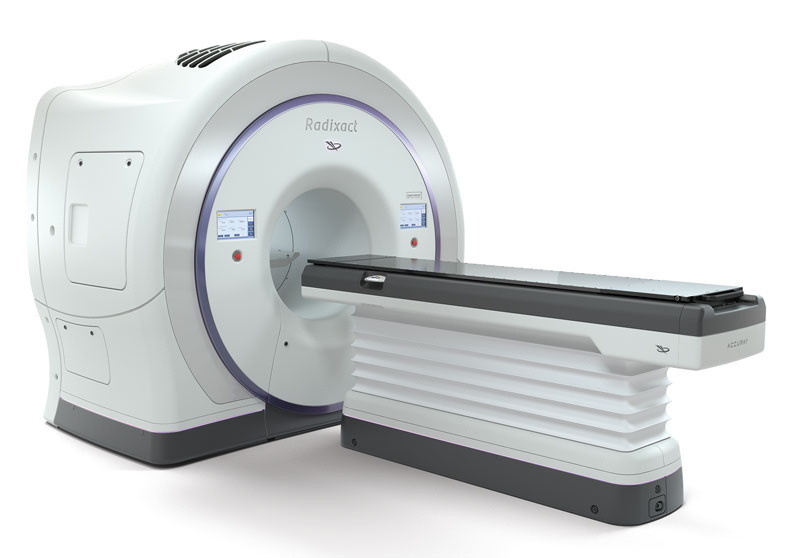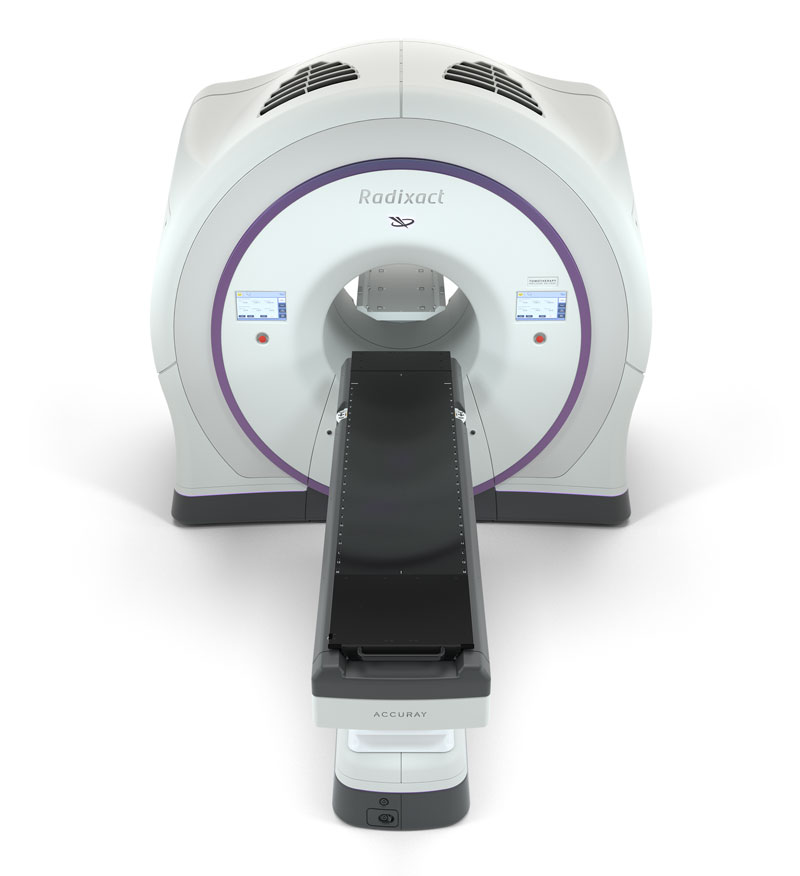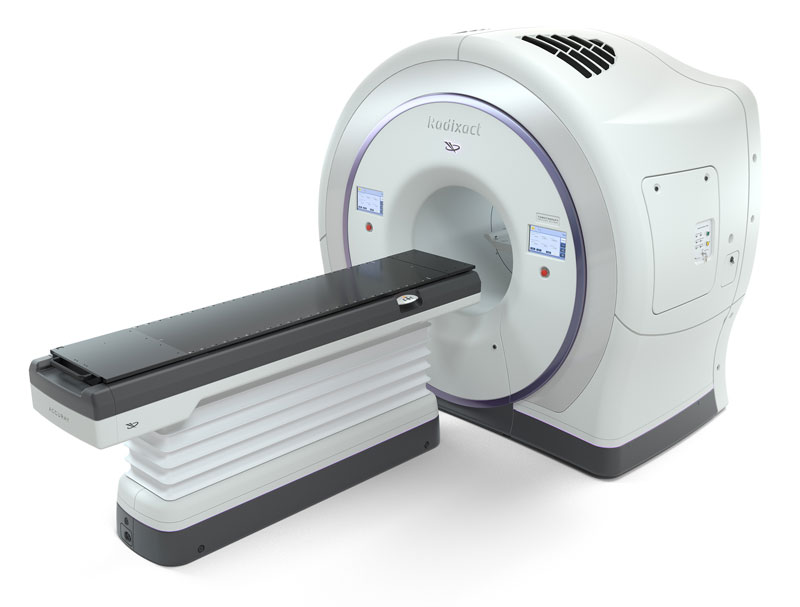Ask a physician if Radixact treatment is right for you
You deserve the best possible treatment for your cervical cancer. Find a physician in your area offering the Radixact System — and find out if Radixact treatment is right for you.
Advances in care mean there are effective treatments for people diagnosed with cervical cancer that can be adapted for their particular medical condition. Radiation therapy is one of the key treatment options. The TomoTherapy® platform, including the next-generation Radixact® System, is the first in the world that is capable of helical radiation delivery – continuously delivering high-quality helical fan-beam imaging for accurate image-guided, intensity-modulated radiation therapy (IG-IMRT) from multiple 360 degree rotations around your body – providing a highly precise, personalized and non-invasive option for treating various stages of cervical cancer.
Radiation therapy is a proven treatment for cervical cancer, and is typically used in combination with chemotherapy with the ultimate goal of curing the disease. Radiation therapy can also be used to treat cancer that has spread or has come back after treatment. However, radiation delivered to surrounding organs, such as the bladder, rectum or bowel, may lead to life-changing side effects, making it critically important for the radiation to be delivered with extreme accuracy and precision. The Radixact System, featuring TomoTherapy technology, combines unique 360 degree treatment delivery from multiple rotations around the patient’s body with powerful dose-sculpting capabilities, providing greater control of the radiation dose so it conforms precisely to the tumor and helps minimize dose to healthy tissue. The result is a radiation therapy treatment that maximizes effectiveness while helping to preserve genitourinary and gastrointestinal function, which may lead to better quality of life for patients both during and after treatment.

You deserve the best possible treatment for your cervical cancer. Find a physician in your area offering the Radixact System — and find out if Radixact treatment is right for you.
The Radixact System with TomoTherapy technology is one of the most integrated, advanced systems for comprehensive cancer treatment available today. The Radixact System enables precise delivery of IG-IMRT, an advanced type of IMRT, for the treatment of cervical cancer. The use of the TomoTherapy technology, as well as IMRT, are supported by published clinical studies.

Radiation therapy can provide a non-surgical, non-invasive treatment option for many cervical cancer patients. An extremely precise type of radiation therapy, called image-guided, intensity-modulated radiotherapy (IG-IMRT), may offer superior dose-delivery to enhance treatment efficacy while helping to reduce the risk of effects.
The TomoTherapy platform, including the next-generation Radixact System, is the only system designed from the ground up to deliver IG-IMRT and was the first to feature helical radiation delivery and integrated CT imaging – providing greater control of the radiation dose so it conforms precisely to the tumor and helps minimize dose to healthy tissue.
Instead of a single beam of radiation, the TomoTherapy platform divides each beam into many smaller, narrow “beamlets.” Every beamlet is individually optimized to a specific intensity of radiation that is targeted at the tumor, enabling customized and precise treatment delivery. Thousands of these beamlets combine in the tumor to contribute to the total radiation dose each patient has been uniquely prescribed. This is called intensity-modulated radiation therapy (IMRT). An enhanced form of IMRT – image-guided intensity-modulated radiation therapy
(IG-IMRT) – uses images acquired before each treatment to help ensure accurate patient and tumor positioning.

As with other cancers, the treatment selected for cervical cancer depends in part on its stage. For early stages, your doctor may recommend radiation (brachytherapy) alone followed by surgery.
For all other stages, radiation and chemotherapy may be given at the same time (referred to as concurrent chemoradiation) and may be the preferred treatment. External beam radiation therapy (EBRT), delivered with machines like the Radixact System, may be used as the main treatment of cervical cancer, usually combined with chemotherapy and followed by brachytherapy. Your doctor may also use EBRT to treat cervical cancers that have spread to other organs and tissues, or cancer that has come back after initial treatment.
The Radixact System provides the flexibility to adapt radiation therapy to any cervical cancer patient’s anatomy, helping to enable the delivery of extremely precise and accurate radiation doses to improve treatment outcomes and help reduce the risk of side effects that may impact patients’ quality of life.
Treatment with the Radixact System is a non-surgical, non-invasive, outpatient procedure that does not require incisions or general anesthesia. Most patients will not require hospitalization or a long recovery time.

Because the precise targeting of the Radixact System significantly reduces irradiation of surrounding healthy tissues, the Radixact System could be a powerful treatment option for patients who have previously undergone radiation or surgical procedures, and experience a recurrence.

References:
1 Lin Y., Chen K., Lu Z. et al. Intensity-modulated radiation therapy for definitive treatment of cervical cancer: a meta-analysis. Radiat Oncol. 2018 Sep 14;13(1):177.
2 Hsieh C.H., Wei M.C., Lee H.Y. et al. Whole pelvic helical tomotherapy for locally advanced cervical cancer: technical implementation of IMRT with helical tomotherapy. Radiat Oncol. 2009 Dec 10;4:62.
3 Gandhi A.K., Sharma D.N., Rath G.K. et al. Early clinical outcomes and toxicity of intensity modulated versus conventional pelvic radiation therapy for locally advanced cervix carcinoma: a prospective randomized study. Int J Radiat Oncol Biol Phys. 2013 Nov 1;87(3):542-8.
4 Naik A, Gurjar OP, Gupta KL, Singh K, Nag P, Bhandari V. Comparison of dosimetric parameters and acute toxicity of intensity-modulated and three-dimensional radiotherapy in patients with cervix carcinoma: A randomized prospective study. Cancer Radiother. 2016 Jul;20(5):370-6.
5 Marjanovic D., Plesinac Karapandzic V., Stojanovic Rundic S. et al. Implementation of intensity-modulated radiotherapy and comparison with three-dimensional conformal radiotherapy in the postoperative treatment of cervical cancer. J BUON. 2019 Sep-Oct;24(5):2028-2034.
6 Klopp A.H., Yeung A.R., Deshmukh S. et al. Patient-Reported Toxicity During Pelvic Intensity-Modulated Radiation Therapy: NRG Oncology-RTOG 1203. J Clin Oncol. 2018 Aug 20;36(24):2538-2544.
© 2024 Accuray Incorporated. All rights reserved.
Educating others about your experience with the Radixact® or TomoTherapy® System can help others who face similar decisions about their own cancer treatment choices.
If you are interested in sharing your story, please fill out the form below and an Accuray representative will contact you.